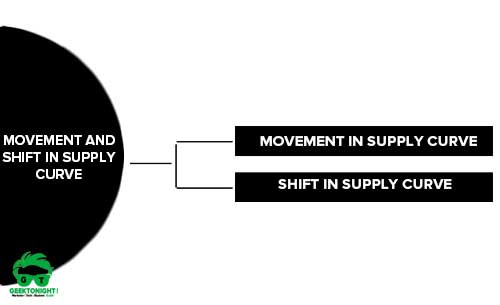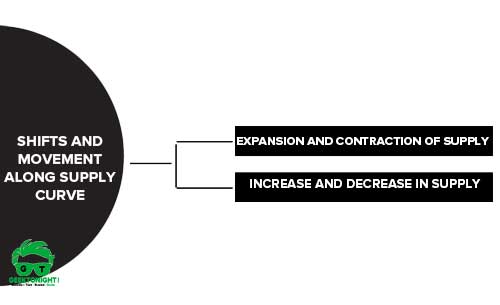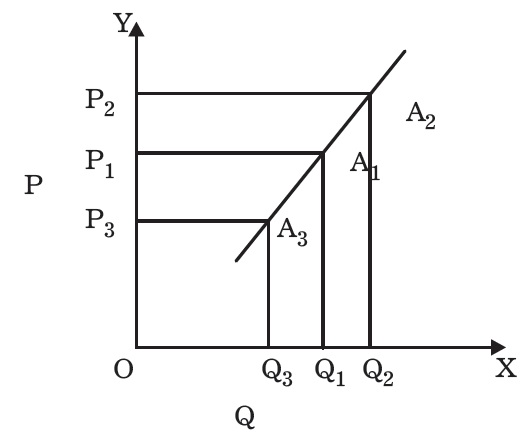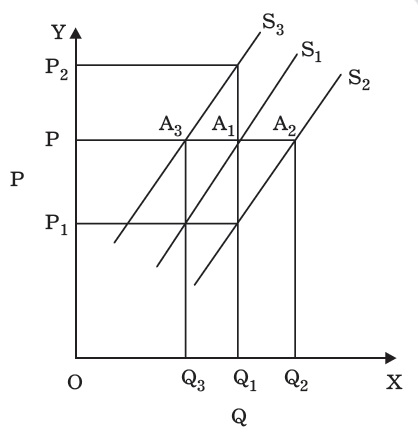Movement and Shift In Supply Curve
- Movement in Supply Curve
- Shift in Supply Curve

Movement in Supply Curve
Movement along Supply Curve is when the commodity experience change in both the quantity supply and price, causing the curve to move in a specific direction.

Table of Content [Show]
Shift in Supply Curve
The shift in supply curve is when, the price of the commodity remains constant, but there is a change in quantity supply due to some other factors, causing the curve to shift to a particular side.
Also Read: What is Supply Curve?
Shifts and Movement along Supply Curve
In economics, like demand, change in quantity supplied and change in supply are two different concepts.

Change in quantity supplied occurs due to rise or fall in product prices while other factors are constant.
- It can be measured by the Movement along Supply Curve.
- The term, Change in quantity supplied refers to expansion or contraction of supply.
Change in supply refers to increase or decrease in the supply of a product due to various determinants of supply other than price (in this case, price is constant).
- It is measured by shifts in supply curve.
- The terms, while a change in supply means an increase or decrease in supply.
Also Read: What is Supply?
Expansion and Contraction of Supply
Expansion or Extension of Supply
Expansion or extension of Supply: When there are large quantities of a good supplied at higher prices, it is known as expansion or extension of supply.
Figure shows the movement of the supply curve:

In Figure, quantity supplied at price OP1 is OQ1. When the price rises to OP2, the quantity supplied also increases to OQ2, which is shown by the upward movement from A1 to A2 (it is pointed by the direction of the arrow between A1 to A2). This upward movement is known as the expansion of supply.
Contraction Of Supply
Contraction of supply occurs when smaller quantities of goods are supplied even at reduced prices.
On the contrary, a fall in price from OP1 to OP3 results in a decrease in supply from OQ1 to OQ2. This movement from A1 to A3 shown by the arrow pointed downwards is known as the contraction of supply. Thus, the movement from A1 to A3 is the representation of the expansion and contraction of the quantity supplied.
Also Read: Law of Supply
Increase and Decrease In Supply
Increase In Supply
An increase in supply takes place when a supplier is willing to offer large quantities of products in the market at the same price due to various reasons, such as improvement in production techniques, fall in prices of factors of production, and reduction in taxes.
Decrease In Supply
A decrease in supply occurs when a supplier is willing to offer small quantities of products in the market at the same price due to increase in taxes, low agricultural production, high costs of labour, unfavourable weather conditions, etc.
Also Read: What is Supply Schedule?
Supply curve shifts
A shift takes place in supply curve due to the increase or decrease in supply, which is shown in Figure.

In Figure, an increase in supply in indicated by the shift of the supply curve from S1 to S2. Because of an increase in supply, there is a shift at the given price OP, from A1 on supply curve S1 to A2 on supply curve S2. At this point, large quantities (i.e. Q2 instead of Q1) are offered at the given price OP.
On the contrary, there is a shift in supply curve from S1 to S3 when there is a decrease in supply. The amount supplied at OP is decreased from OQ1 to OQ3 due to a shift from A1 on supply curve S1 to A3 on supply curve S3.
However, a decrease in supply also occurs when producers sell the same quantity at a higher price (which is shown in Figure) as OQ1 is supplied at a higher price OP2.
Leave a Reply